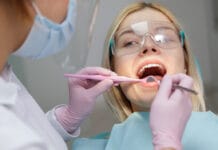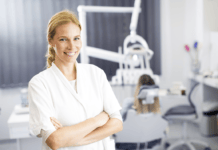Much emphasis has been given to prenatal oral care of patients, which is essential because 60% to 75% of pregnant women have gingivitis, and one in four women of childbearing age have untreated caries.1 However, with so much emphasis on the dental care of the mother, what happens when the baby arrives?
The mother doubtlessly is busy thinking about clothing, bedding, strollers, and the like. It is the dental hygienist’s job to bring the mother’s attention to the oral care of the newborn.
We often tell parents to bring the baby to the dentist by the age of one or when the first tooth appears. This appointment is generally used to discuss the care of teeth and nutrition, but it can also be used to assess for tethered tissues and airway issues. However, the average child has their first tooth erupt around six months, long after patterns of care have been established in the home. It would be much more productive to inform parents of healthy oral care before the child arrives instead of trying to correct behavior at the first dental visit.
Setting the Stage
Most expecting mothers are eager to talk about plans for the new arrival. At their hygiene appointment, show a personal interest in the patient by asking about possible names, nursery decorations, or due dates. From there, you can set the stage for oral implications of pregnancy for the mother. At that point, it is an easy transition to talk about the baby’s oral care.
If the parent has oral disease themselves, they may be interested to know that the bacteria that causes such conditions can be passed on to their baby. Help them understand that caries and periodontal diseases, though multifactorial, are caused by bacteria, which can easily be introduced to the baby’s mouth by sharing spoons or cups. Parents and caregivers are usually the first source of infectious bacteria because of intimate contact with the child in the first two years of life.2
Therefore, we can emphasize the importance of the parents’ own oral care to reduce their bacterial load and talk about strategies to reduce the risk of infection, such as not sharing utensils.
Feeding Infants
Another topic that the parent should be thinking about at this point is initial nutrition. If possible, breastfeeding has distinct advantages for oral and facial development, which is key to a healthy airway and overall health. Breastfeeding has been shown to promote nasal breathing, better tongue positioning, correct palate formation, and prevent atypical swallowing patterns.3
The risk of early childhood caries is greatly reduced with breastfeeding when compared to bottle feeding because the infant is less likely to hold the liquid in their mouth. However, breastfeeding is not a cure-all; do make sure the parent knows that breast milk also contains sugars and can still cause decay.4
If they are going to bottle feed, stress that only formula, breast milk, or water should be in the bottle. Some parents have been known to dip pacifiers in sugar or honey, introducing unnecessary sugar that should be discouraged.
After feedings, whether bottle or breastfed, the mouth needs to be cleaned. Within a few days after birth, a small, clean washcloth or gauze can be used to clean off the gingiva after feedings.4 This accomplishes a couple of things. While it certainly helps maintain cleanliness, it also gets the child used to the sensation of cleansing well before teeth erupt, so they are more likely to be cooperative later.
Possible Strategy
Often, medical doctors gift a prenatal patient a care pack, including basic necessities for their new arrival. This idea could also be a nice way to open a discussion with the patient about infant dental care. It could include a finger brush, a small soft washcloth, a teething ring, baby toothpaste, and maybe a sippy cup. We could go through the supplies and explain the uses and reasoning behind our recommendations. When incorporating this into the prenatal hygiene visit, we allow patients time to think about their baby’s oral care and answer any questions.
In Closing
Relaying this important information at prenatal visits can help prevent problems before they start. We can empower patients to make good choices about their children’s oral care instead of trying to correct behavior and repair damage after the fact.
During the prenatal visit, parents are often open to information and curious about what lies in their future. This is in contrast to the possibly defensive position parents may take at their child’s exam when they might feel like we are criticizing their parenting. We foster a good working relationship with the patient by being proactive and setting them up for success.
Before you leave, check out the Today’s RDH self-study CE courses. All courses are peer-reviewed and non-sponsored to focus solely on pure education. Click here now.
Listen to the Today’s RDH Dental Hygiene Podcast Below:
References
- Pregnancy and Oral Health. (2022, March 18). Centers for Disease Control and Prevention. https://www.cdc.gov/oralhealth/publications/features/pregnancy-and-oral-health.html
- Damle, S.G., Yadav, R., Garg, S., et al. Transmission of Mutans streptococci in Mother-child Pairs. The Indian Journal of Medical Research. 2016; 144(2): 264-270. https://www.ncbi.nlm.nih.gov/pmc/articles/PMC5206879/
- Anyanechi, C.E., Ekabua, K.J., Ekpenyong, A.B., Ekabua, J.E. Parturients’ Awareness and Perception of Benefits of Breast Feeding in the Prevention of Infant and Childhood Oral and Dental Diseases. Ghana Medical Journal. 2017; 51(2): 83-87. https://www.ncbi.nlm.nih.gov/pmc/articles/PMC5611903/
- Breastfeeding: 6 Things Nursing Moms Should Know About Dental Health. (n.d.). Mouth Healthy. https://www.mouthhealthy.org/en/az-topics/b/breastfeeding












